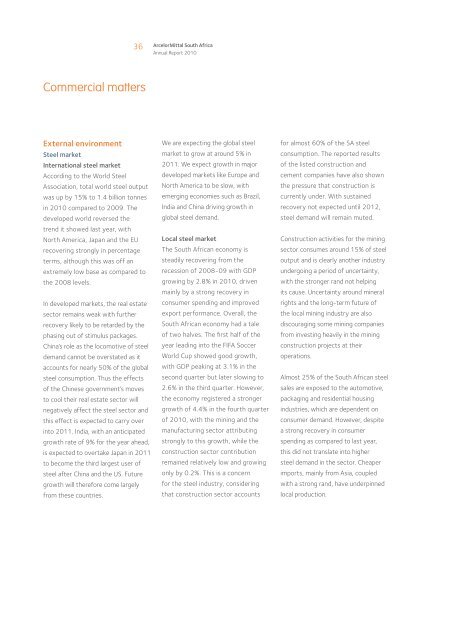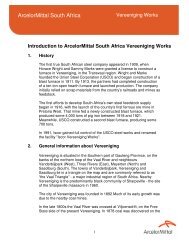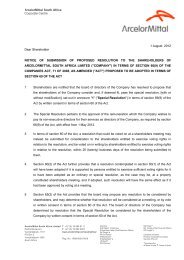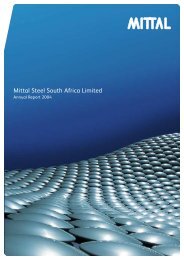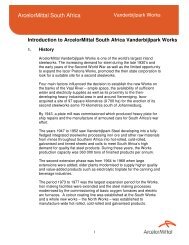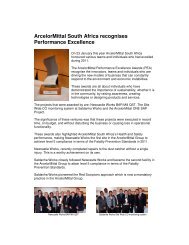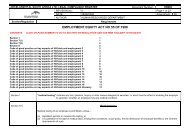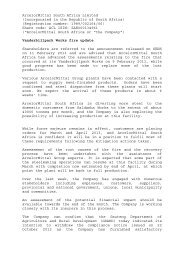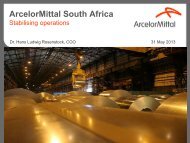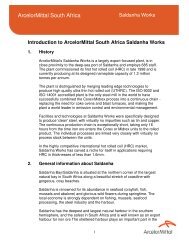bold spirit - ArcelorMittal South Africa
bold spirit - ArcelorMittal South Africa
bold spirit - ArcelorMittal South Africa
Create successful ePaper yourself
Turn your PDF publications into a flip-book with our unique Google optimized e-Paper software.
36<br />
<strong>ArcelorMittal</strong> <strong>South</strong> <strong>Africa</strong><br />
Annual Report 2010<br />
Commercial matters<br />
External environment<br />
Steel market<br />
International steel market<br />
According to the World Steel<br />
Association, total world steel output<br />
was up by 15% to 1.4 billion tonnes<br />
in 2010 compared to 2009. The<br />
developed world reversed the<br />
trend it showed last year, with<br />
North America, Japan and the EU<br />
recovering strongly in percentage<br />
terms, although this was off an<br />
extremely low base as compared to<br />
the 2008 levels.<br />
In developed markets, the real estate<br />
sector remains weak with further<br />
recovery likely to be retarded by the<br />
phasing out of stimulus packages.<br />
China’s role as the locomotive of steel<br />
demand cannot be overstated as it<br />
accounts for nearly 50% of the global<br />
steel consumption. Thus the effects<br />
of the Chinese government’s moves<br />
to cool their real estate sector will<br />
negatively affect the steel sector and<br />
this effect is expected to carry over<br />
into 2011. India, with an anticipated<br />
growth rate of 9% for the year ahead,<br />
is expected to overtake Japan in 2011<br />
to become the third largest user of<br />
steel after China and the US. Future<br />
growth will therefore come largely<br />
from these countries.<br />
We are expecting the global steel<br />
market to grow at around 5% in<br />
2011. We expect growth in major<br />
developed markets like Europe and<br />
North America to be slow, with<br />
emerging economies such as Brazil,<br />
India and China driving growth in<br />
global steel demand.<br />
Local steel market<br />
The <strong>South</strong> <strong>Africa</strong>n economy is<br />
steadily recovering from the<br />
recession of 2008-09 with GDP<br />
growing by 2.8% in 2010, driven<br />
mainly by a strong recovery in<br />
consumer spending and improved<br />
export performance. Overall, the<br />
<strong>South</strong> <strong>Africa</strong>n economy had a tale<br />
of two halves. The first half of the<br />
year leading into the FIFA Soccer<br />
World Cup showed good growth,<br />
with GDP peaking at 3.1% in the<br />
second quarter but later slowing to<br />
2.6% in the third quarter. However,<br />
the economy registered a stronger<br />
growth of 4.4% in the fourth quarter<br />
of 2010, with the mining and the<br />
manufacturing sector attributing<br />
strongly to this growth, while the<br />
construction sector contribution<br />
remained relatively low and growing<br />
only by 0.2%. This is a concern<br />
for the steel industry, considering<br />
that construction sector accounts<br />
for almost 60% of the SA steel<br />
consumption. The reported results<br />
of the listed construction and<br />
cement companies have also shown<br />
the pressure that construction is<br />
currently under. With sustained<br />
recovery not expected until 2012,<br />
steel demand will remain muted.<br />
Construction activities for the mining<br />
sector consumes around 15% of steel<br />
output and is clearly another industry<br />
undergoing a period of uncertainty,<br />
with the stronger rand not helping<br />
its cause. Uncertainty around mineral<br />
rights and the long-term future of<br />
the local mining industry are also<br />
discouraging some mining companies<br />
from investing heavily in the mining<br />
construction projects at their<br />
operations.<br />
Almost 25% of the <strong>South</strong> <strong>Africa</strong>n steel<br />
sales are exposed to the automotive,<br />
packaging and residential housing<br />
industries, which are dependent on<br />
consumer demand. However, despite<br />
a strong recovery in consumer<br />
spending as compared to last year,<br />
this did not translate into higher<br />
steel demand in the sector. Cheaper<br />
imports, mainly from Asia, coupled<br />
with a strong rand, have underpinned<br />
local production.


